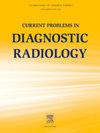急性肾盂肾炎的治疗反应评估:基于多读取器 DWI 的磁共振成像方法
IF 1.5
Q3 RADIOLOGY, NUCLEAR MEDICINE & MEDICAL IMAGING
引用次数: 0
摘要
目的评价基于弥散加权成像(DWI)的MRI方法在急性肾盂肾炎(APN)治疗反应评估中的诊断准确性。此外,我们还探讨了读者体验对SRS和DWI解释的影响,包括病变显著性和表观扩散系数(ADC)图的测量。方法回顾性分析2021年9月至2023年6月期间36例APN患者的dwi mri随访结果。随访血液炎症指标作为参考标准。使用结构化报告评分(SRS)评估治疗反应。每位读者对DWI上残留病变的“显著性”打分从1到3。定量ADC测量与Mann-Whitney U检验进行比较。计算描述性统计量和类内相关系数(ICC)。结果Reader 1、2、3的SRS诊断准确率分别为80.6%、76.9%、72.2%。ICC从0.82(读者1和2)下降到0.68(考虑所有读者)。平均可见度在2.3到2.7之间。Reader 1和Reader 2完全应答者的ADC值显著更高(153.5-154.5 vs 107.7-116.2, p <;0.001)。读者1和2的ICC为良好(0.89),考虑到所有读者的ICC为中等(0.60)。结论基于dwi的MRI可准确评估肾盂肾炎的治疗效果,避免不必要的造影剂使用和辐射暴露。SRS和DWI分析显示了良好的观察者间一致性,但对于不太专业的读者来说,可能需要一定的学习曲线。本文章由计算机程序翻译,如有差异,请以英文原文为准。
Treatment response assessment of acute pyelonephritis: A multi-reader DWI-based MRI approach
Purpose
To evaluate the diagnostic accuracy of a structured reporting score (SRS) in treatment response assessment for acute pyelonephritis (APN) using a diffusion-weighted imaging (DWI) -based MRI approach. Additionally, we explored the influence of reader experience on the interpretation of SRS and DWI, including lesion conspicuity and measurements of Apparent Diffusion Coefficient (ADC) maps.
Methods
Follow-up DWI-based MRIs of 36 patients treated for APN between September 2021 and June 2023 were retrospectively reviewed by three readers. Follow-up blood inflammatory markers were used as reference standard. Treatment response was assessed using a structured reporting score (SRS). Each reader assigned a score from 1 to 3 to the "conspicuity" of the residual disease on DWI. Quantitative ADC measurements were compared with the Mann-Whitney U test. Descriptive statistics and Intraclass Correlation Coefficient (ICC) were calculated.
Results
The diagnostic accuracy of SRS was 80.6 %, 76.9 %, and 72.2 % for the Reader 1, 2, and 3 respectively. ICC decreased from 0.82 (Reader 1 and 2), to 0.68 when considering all readers. The average conspicuity varied between 2.3 and 2.7. ADC values were significantly higher in complete responders for Reader 1 and 2 (153.5-154.5 vs 107.7-116.2, p < 0.001). The ICC was good (0.89) for Reader 1 and 2 and moderate (0.60) when considering all readers.
Conclusions
Treatment response of pyelonephritis can be accurately assessed by a DWI-based MRI, potentially avoiding unnecessary contrast agent administration and radiation exposure. SRS and DWI analysis showed a good inter-observer agreement but a certain learning curve may be necessary for less expert readers.
求助全文
通过发布文献求助,成功后即可免费获取论文全文。
去求助
来源期刊

Current Problems in Diagnostic Radiology
RADIOLOGY, NUCLEAR MEDICINE & MEDICAL IMAGING-
CiteScore
3.00
自引率
0.00%
发文量
113
审稿时长
46 days
期刊介绍:
Current Problems in Diagnostic Radiology covers important and controversial topics in radiology. Each issue presents important viewpoints from leading radiologists. High-quality reproductions of radiographs, CT scans, MR images, and sonograms clearly depict what is being described in each article. Also included are valuable updates relevant to other areas of practice, such as medical-legal issues or archiving systems. With new multi-topic format and image-intensive style, Current Problems in Diagnostic Radiology offers an outstanding, time-saving investigation into current topics most relevant to radiologists.
 求助内容:
求助内容: 应助结果提醒方式:
应助结果提醒方式:


